Simply lovely with plenty of space

Today, Opel and Fiat belong to the same group: Stellantis. That was not yet the case when the two competing C-segment station wagons from this test were new in the showroom six to seven years ago. The only similarity is that they both have a 1.4-liter turbo engine.
Opel Astra Sports Tourer 1.4 Turbo Innovation | 2017 | 91,500 km | €15,400
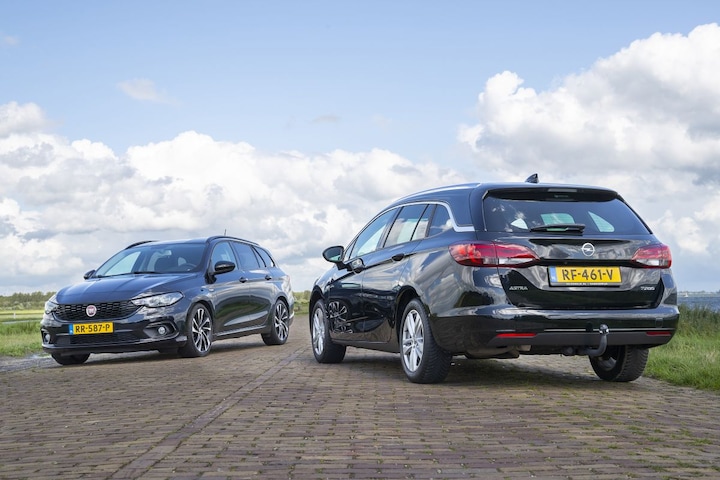
Fiat Tipo SW 1.4 T-Jet S-Design | 2018 | 103,500 km | €14,700
Who would have ever imagined that Opel and Fiat would fall under the same umbrella, along with another twelve brands, including Peugeot and Citroën? Stellantis is a global player with its headquarters in Amsterdam. After being part of General Motors for more than eighty years, Opel has been owned by the PSA Group since August 2017. That takeover should not have come a moment later. Fiat merged with Chrysler in 2014 to form FCA, which in turn merged with PSA in 2021. This is how Stellantis was born. So much for some background information, we now focus on the main characters.
Fiat Tipo returned in 2015 as a hatchback, sedan and station wagon
We already know the name Tipo from the 1980s, when Fiat introduced a new hatchback as the successor to the Ritmo. With that Tipo, the Italians were unable to make any progress in the segment in which the Volkswagen Golf, Opel Kadett and Ford Escort dominated at the time. In 2015, Fiat presented a sedan with the time-honored name Tipo and about a year later the hatchback and station wagon appeared. The new Opel Astra made its debut almost at the same time as the Tipo. That is the Astra K (counting started with the Kadett A in 1962). One of the spearheads for that model was weight reduction and that was successful; a five-door Astra K 1.4 Turbo is 140 kilos lighter than its predecessor and also weighs less than the Tipo SW in this comparison. That certainly saves on taxes and consumption.
Fiat Tipo not a bestseller
At the time of writing, the Fiat Tipo has been in our price list for almost eight years and less than 2,100 units have been sold in the Netherlands. Last year the counter stopped after a paltry 98 copies. Logically, you hardly encounter it in daily traffic. The basic engine is a naturally aspirated 1.4 16V with 95 hp. If you want an automatic, you will have to rely on a 1.6 16V of 110 hp, also without turbo. As diesel we see the 1.3 and 1.6 MultiJet, two four-cylinders. The facelift was available in 2021 and was accompanied by the arrival of a new engine: the three-cylinder 1.0 FireFly (100 hp) and the 1.5 Hybrid (130 hp) was added in 2022. The Tipo was slowly phased out in 2023 and we are waiting for an SUV-like successor. Our test car has the most popular powertrain, the 1.4 T-Jet, which debuted in 2017. This is an engine that Alfa Romeo used for the Giulietta, among others, with power up to 170 hp. We now do it with 120 hp and 215 Nm.
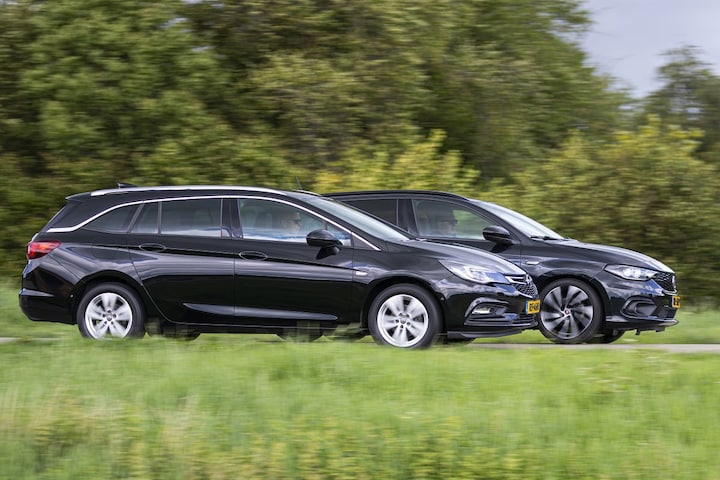
If we look at the sales results of the Astra, we see almost ten thousand units in the first two years after its debut. Then he sank. Not surprising, because we also saw that happen with the Golf and the Focus. At its debut, the Astra was also available with a 1.0-liter three-cylinder with turbo (105 hp), while the most powerful petrol engine was a 1.6 with 200 hp. The diesel was a four-cylinder 1.6, with 100 to 160 hp. In 2019, the Astra was refreshed and received a new three-cylinder: a 1.2 petrol (110/130 hp) and a 1.5 diesel, strangely enough not from PSA, but from GM. Since 2021 we have known the current Astra, a sister model of the Peugeot 308.
Despite equivalent technology, there is quite a difference in consumption. For the Tipo, Fiat specifies 6.0 liters per 100 kilometers, which is 1 in 16.7. In practice this turns out to be 7.8 liters per 100 kilometers. That amounts to 1 in 12.8. The Opel as we drive it should be able to achieve 1:18.2, but in practice it turns out to be 1:14.8

As far as we are concerned, the fact that the general public passes by the Tipo is not due to its appearance. The Italians have managed to create a nice car. Maybe it has a somewhat interchangeable design; it is certainly not as eccentric as the first Ritmo or the Bravo. Simply a neat appearance. The interior is more playful than that of most European cars, but it could have used some color for fun.

Furthermore, it is noticeable that the materials on the center console and for the door panels look cheap and are very hard. The seating position is good, just like the seat itself. Both front seats are height adjustable. What is already irritating before driving away is the difficult shifting and this does not get any better while driving. The box is difficult to operate and we hardly ever experience that these days. The turbo engine is not as temperamental as you would expect from an Italian and it sounds a bit raw. The rest of the driving sounds are also a bit too loud. Unfortunately, all this is not compensated by appealing driving characteristics. It’s all a bit of meat and fish and that is why the Tipo does not distinguish itself in this area. The controls can be made a bit lighter by pressing the ‘City’ button. We know this from other Fiats: parking with your little finger. The infotainment system has a smartphone display and can be easily operated via the screen and two rotary push buttons. Driving assistance is available in the form of adaptive cruise control. Due to the lack of assistance systems, the Tipo only received three stars from Euro NCAP.
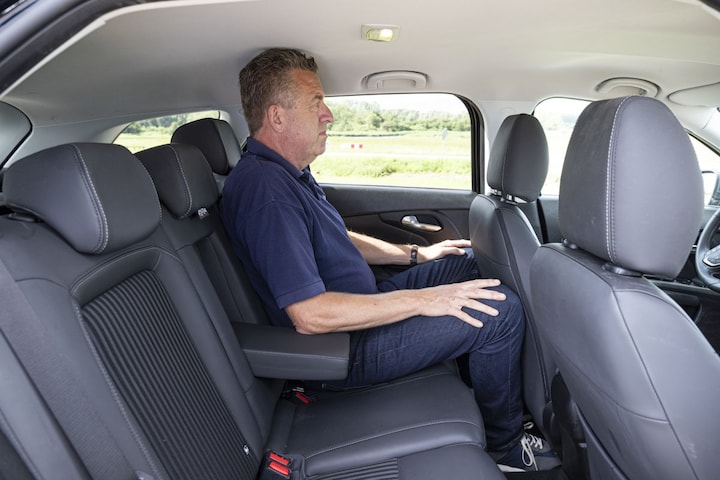
Fiat Tipo SW: slightly less spacious than the Opel, but at 1.90 meters it still fits in the back.
When we see the two cars next to each other during the photo session, the Opel looks older than the Fiat. And then there is that typical chrome strip that runs downwards in a curve at the end and evokes the association with a hearse for us and many others, especially in combination with this color and body shape. The Opel Adam, Crossland and Mokka wear the same decoration. Opel has made extensive use of piano lacquer for the interior. Furthermore, the other materials appear to be of higher quality than those of the Tipo.
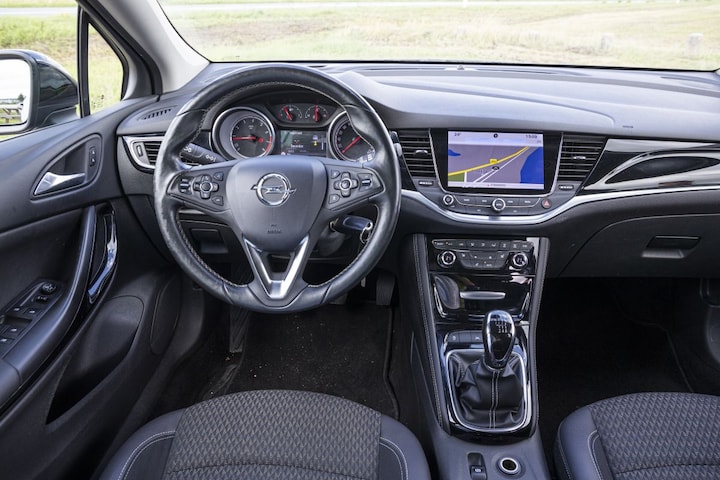
The instrumentation is typical Opel from those years, with two large and two small round clocks. Centrally and integrated into the dashboard we see the screen of the infotainment system and the apps from your smartphone can also be displayed here, so that you are assured of good navigation. The Astra drives surprisingly well, something we have already experienced in previous tests. The Ford Focus may be considered a benchmark in its class, but this Opel also feels nice and light-footed and its steering is unexpectedly sharp. He combines this with a good chassis, where suspension and damping work in harmony. In addition, the Astra is quieter across the board than the Tipo, which contributes to driving comfort. The engine is not a further development of the earlier 1.4, but completely new. You will notice from the first moment that you have more torque and power and shifting will be smoother. He also knows how to combine better performance with lower consumption. The lane assistant is still one of the early types and often causes irritation. Together with the other safety systems, this gave the Astra a five-star score in the Euro NCAP in 2015. That’s an excellent score. Coming back to the Tipo’s collision score: equipped with City Safety Stop (automatic braking in built-up areas when a pedestrian is crossing) and traffic sign recognition, it achieved four stars, but even based on those three stars you don’t have to be afraid of to sit on a moving crinkle chip, because the Tipo’s carriage is highly resistant to a collision. Moreover, its adaptive cruise control makes it safer than the Astra in a certain respect. In the Opel we see a button on the steering wheel with a symbol that also suggests automatic cruise control, but it turns out to be the alertness of the distance meter and therefore a collision warning. And the Opel may have an emergency call, but two years after the brand was acquired by PSA, this system (GM’s OnStar) no longer works.
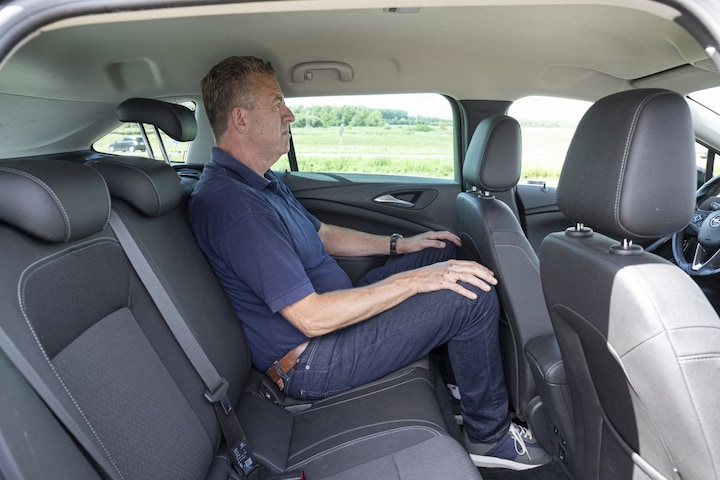
Both test cars are otherwise well equipped; the Opel also has heated seats in the back and it can park automatically. The Fiat offers adaptive cruise control and larger wheels, while the Opel has a tow bar, with a remarkable towing weight of 1,403 kg; for the Fiat this is 1,500 kg. When it comes to cargo space, the differences are minimal. Quite remarkable, because the Fiat is 13 centimeters shorter than the Opel. The Astra has a narrow advantage on the back seat, perhaps due to the three centimeters longer wheelbase. Anyway, two excellent all-rounders.
Select from reviews from Astra drivers about their car:
• “The parking sensors already beep when you are waiting at a traffic light at a reasonable distance from the vehicle in front.”
• “Strong advice for those considering an Astra: go for the AGR seats.”
• “The average consumption over 186,000 km is 6.9 liters per 100 km (1:14.5).”
• “You shouldn’t expect too much about the lane assistance: it regularly fails to see lines.”
• “An underrated car, which you first have to drive to discover its qualities.”
• “Consumption is top, with an average of 1 in 14.7.”
Select from reviews from Tipo drivers about their car:
• “After almost 17,000 km, the standard consumption was almost exactly 1 in 16.6.”
• “After three years and 45,000 kilometers without any problems, I am still satisfied.”
• “The space in the back is slightly less than my previous Skoda Rapid.”
• “Okay, the door panels are made of hard plastic, but that doesn’t matter to me.”
• “The engine is smooth and performs well from 1,400 rpm.”
• “The on-board computer is too optimistic. The car is very inefficient on short journeys.”
– Thanks for information from Autoweek.nl